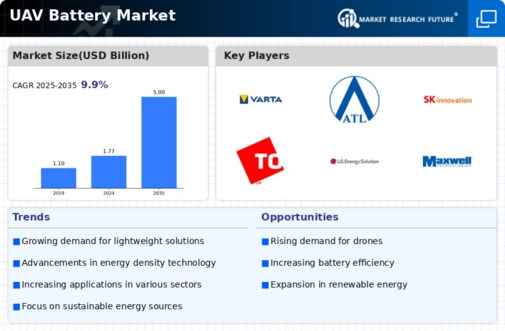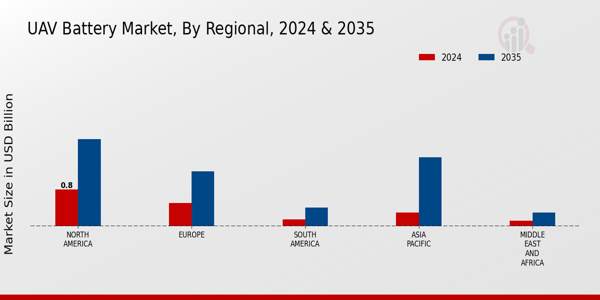Market Trends
Introduction
As we enter 2024, the UAV Battery Market is experiencing significant transformation driven by a confluence of macro factors. Technological advancements in battery chemistry and energy density are enabling longer flight times and enhanced performance for unmanned aerial vehicles. Concurrently, regulatory pressures aimed at promoting sustainable practices are pushing manufacturers to innovate in eco-friendly battery solutions. Additionally, shifts in consumer behavior, particularly the growing demand for efficient and reliable drone applications across various sectors, are reshaping market dynamics. These trends are strategically important for stakeholders, as they not only influence product development and competitive positioning but also dictate the future landscape of UAV operations and applications.
Top Trends
-
Increased Demand for High-Energy Density Batteries
The UAV market is witnessing a surge in demand for high-energy density batteries, driven by the need for longer flight times. Industry leaders are investing in advanced lithium-ion technologies, with companies reporting energy densities exceeding 300 Wh/kg. This trend is crucial for applications in delivery drones and surveillance, where extended operational range is essential. Future developments may include solid-state batteries, which promise even higher energy densities and safety. -
Sustainability and Eco-Friendly Battery Solutions
Sustainability is becoming a priority, with companies exploring eco-friendly battery materials and recycling processes. For instance, several manufacturers are investing in lithium-sulfur and sodium-ion batteries, which offer lower environmental impact. Governments are also incentivizing green technologies, leading to a shift in production practices. This trend could reshape supply chains and encourage innovation in sustainable battery technologies. -
Advancements in Fast-Charging Technologies
Fast-charging capabilities are becoming critical for UAV operations, reducing downtime and increasing efficiency. Companies are developing ultra-fast charging systems that can recharge batteries to 80% in under 30 minutes. This advancement is particularly beneficial for commercial applications, such as package delivery. Future implications may include the standardization of fast-charging protocols across the industry. -
Integration of Smart Battery Management Systems
Smart battery management systems (BMS) are increasingly being integrated into UAV batteries to enhance performance and safety. These systems monitor battery health, optimize charging cycles, and predict maintenance needs. Industry leaders are reporting improved operational efficiency and reduced failure rates. The future may see AI-driven BMS that further enhance predictive analytics and operational insights. -
Regulatory Support for UAV Battery Innovations
Governments are establishing regulations that support the development and deployment of advanced UAV battery technologies. For example, the FAA has introduced guidelines that encourage the use of safer battery chemistries. This regulatory support is fostering innovation and investment in the sector. As regulations evolve, they may also drive standardization across battery technologies, enhancing interoperability. -
Emergence of Modular Battery Designs
Modular battery designs are gaining traction, allowing for easy replacement and scalability in UAV applications. This trend is being driven by the need for customizable solutions that can adapt to various UAV sizes and missions. Companies are reporting increased flexibility in operations and reduced maintenance costs. Future developments may lead to fully interchangeable battery systems across different UAV models. -
Focus on Safety and Reliability Enhancements
Safety remains a top priority, with manufacturers investing in technologies to prevent thermal runaway and battery failures. Recent advancements include the use of fire-resistant materials and advanced cooling systems. This focus on safety is crucial for regulatory compliance and public acceptance of UAVs. Future innovations may lead to the development of inherently safe battery chemistries. -
Collaboration Between Battery and UAV Manufacturers
Collaborations between battery manufacturers and UAV developers are becoming more common, leading to tailored battery solutions. For instance, partnerships are focusing on optimizing battery performance for specific UAV applications, enhancing overall efficiency. This trend is fostering innovation and accelerating product development cycles. Future collaborations may expand to include research institutions for cutting-edge battery technologies. -
Growth of Battery Leasing Models
Battery leasing models are emerging as a viable business strategy, allowing UAV operators to reduce upfront costs. Companies are offering subscription-based services for battery usage, which can lower financial barriers for new entrants. This trend is expected to enhance market accessibility and encourage more businesses to adopt UAV technologies. Future developments may include flexible leasing terms based on usage patterns. -
Increased Investment in R&D for Next-Gen Batteries
Investment in research and development for next-generation battery technologies is on the rise, with companies allocating significant resources to innovation. Reports indicate that R&D spending in the battery sector has increased by over 20% in the past year. This trend is crucial for maintaining competitive advantage and addressing future market demands. The focus may shift towards breakthroughs in energy storage and efficiency.
Conclusion: Navigating the UAV Battery Market Landscape
The UAV battery market in 2024 is characterized by intense competitive dynamics and significant fragmentation, with both legacy and emerging players vying for market share. Regional trends indicate a growing emphasis on sustainability and innovation, particularly in North America and Europe, where regulatory frameworks are increasingly favoring eco-friendly solutions. Vendors are strategically positioning themselves by leveraging advanced capabilities such as AI for predictive analytics, automation for production efficiency, and flexibility in product offerings to meet diverse customer needs. As the market evolves, leadership will be determined by the ability to integrate these capabilities effectively, ensuring that companies not only meet current demands but also anticipate future trends in UAV technology.













Leave a Comment